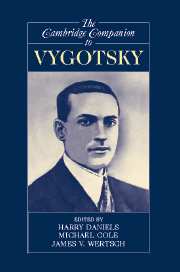Book contents
- Frontmatter
- Editors’ Introduction
- Part I: Vygotsky in Context
- Part II: Readings of Vygotsky
- Part III: Applications of Vygotsky’s Work
- 12 Pedagogy
- 13 Sociocultural Theory and Education of Children with Special Needs: From Defectology to Remedial Pedagogy
- 14 Putting Vygotsky to Work: The Change Laboratory as an Application of Double Stimulation
- References
- Index
14 - Putting Vygotsky to Work: The Change Laboratory as an Application of Double Stimulation
from Part III: - Applications of Vygotsky’s Work
Published online by Cambridge University Press: 28 November 2007
- Frontmatter
- Editors’ Introduction
- Part I: Vygotsky in Context
- Part II: Readings of Vygotsky
- Part III: Applications of Vygotsky’s Work
- 12 Pedagogy
- 13 Sociocultural Theory and Education of Children with Special Needs: From Defectology to Remedial Pedagogy
- 14 Putting Vygotsky to Work: The Change Laboratory as an Application of Double Stimulation
- References
- Index
Summary
INTRODUCTION
This chapter examines Vygotsky's method of double stimulation as a basis for formative interventions in the workplace. I argue that double stimulation is radically different from such intervention approaches as the design experiments currently discussed in educational research. Double stimulation is, above all, aimed at eliciting new, expansive forms of agency in subjects. In other words, double stimulation is focused on making subjects masters of their own lives.
First, I will present Vygotsky's double stimulation as a theoretical and methodological idea. I will then examine recent notions of “design experiments” and point out some serious limitations in these experiments. Second, I will introduce the Change Laboratory method developed in the Center for Activity Theory and Developmental Work Research and used for ten years in formative interventions in workplaces. Third, I will discuss this method as an application and expansion of double stimulation. Fourth, I will demonstrate the practical implementation of Change Laboratory with an example from a project carried out in Finnish post offices. Fifth, I will conclude the chapter with a discussion of some methodological and theoretical implications of the Change Laboratory method for further development of Vygotskian research, especially as it is applied in the context of the workplace and organizations.
- Type
- Chapter
- Information
- The Cambridge Companion to Vygotsky , pp. 363 - 382Publisher: Cambridge University PressPrint publication year: 2007
- 137
- Cited by



